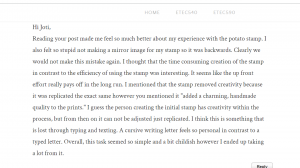Tipping Point Assignment:
A Critical Case Study of the Shift from External Storage to Cloud Computing
A tipping point represents a moment when incremental changes lead to a significant and often irreversible shift. With the rapid growth of technology, changes occur often. The transition from external storage to the cloud represents a significant tipping point in technology. External storage devices, such as hard drives, USB flash drives, and external SSDs, have long been the primary means for individuals and organizations to store and manage their digital data. However, cloud computing and storage has greatly impacted this by offering valuable benefits over external storage.
What is cloud computing? “A widely used definition was issued by the National Institute of Standards and Technology (NIST), which defines cloud computing as “a model for enabling ubiquitous, convenient, on-demand network access to a shared pool of configurable computing resources (e.g., networks, servers, storage, applications, and services) that can be rapidly provisioned and released with minimal management effort or service provider interaction” (Wolfschwenger et al., 2020).
It is challenging to pinpoint an exact date when USB storage definitively “gave way” to the cloud, as both methods continue to coexist and serve different purposes for users. “USB portable hard drives emerged onto the consumer market in the early 2000s as an alternative form of data storage to 3.5-inch floppy disks and CD-ROMs” (Kennedy and Wilken, 2016, p. 2). Whereas cloud storage as a concept evolved over time. The modern idea of cloud storage, where data is stored and accessed over the internet, began to take shape in the late 1990s and early 2000s. Companies like Amazon, Google, and others started offering cloud storage services in the early 2000s (Aaron & Roche, 2011). This is when it became more widely adopted by businesses and individuals due to advancements in internet connectivity, storage technologies, and the proliferation of digital data. “Growing rapidly in recent years, the cloud has become a critical part of the digital infrastructure of many businesses” (Law, 2023). It did take time for users, specifically educators, to feel comfortable using cloud storage. However, it is now a worldwide, 57-billion-dollar industry (Law, 2023).
One of the key figures in the development of cloud computing, which includes cloud storage, is Joseph Carl Robnett Licklider, known as J.C.R. Licklider. Licklider was an American psychologist and computer scientist who played a crucial role in the development of ARPANET, the precursor to the internet (Nemenyi, 2019). He envisioned a future in which computers would be interconnected and users could access programs and data from anywhere. His vision laid the foundation for cloud computing and cloud storage as we know them today. Nemenyi also writes that it was Licklider along with others who “would transform the digital computer from the solitary monolithic calculator that it had been from von Neumann’s invention into the graphical, interactive, windowed, mouse-driven, multi-purpose, hyperlinked and internetworked computer that we know today” (Nemenyi, 2019, p.12). While cloud storage has evolved as a collaborative effort among many individuals and organizations, there isn’t a single individual who is most associated with creating cloud storage. Instead, it has been a collective effort driven by the technological advancements and innovations of the broader tech industry.
External storage lost ground to cloud computing in education technology because of the many benefits it provides students and educators. Cloud computing platforms, such as Amazon Web Services (AWS), Microsoft Azure, and Google Cloud Platform (GCP), provide users with virtualized storage resources that can be accessed from anywhere with an internet connection. This shift to cloud-based storage provides benefits such as accessibility and convenience, allowing users to access their data from anywhere with reliable internet, and increases ease of collaboration and sharing.
The shift from using external to online storage in education can be largely attributed to the Internet’s transformative impact on how we access, store, and share information. As the internet has grown, teachers have had to evolve and change to meet the demands of a digitally connected world. They have had to adapt their teaching methods to incorporate digital tools and resources, such as online learning platforms, educational apps, and multimedia content, to enhance student engagement and learning outcomes. Additionally, teachers have had to develop new skills and competencies, such as digital literacy and the ability to evaluate online information, to effectively navigate the vast amount of information available on the internet. The internet is a powerful platform that has changed how people interact with each other and access information. As educators have embraced the internet, they have specifically had to explore ways to store files, synchronize files, create new documents, and collaborate. This has all been possible because of cloud computing. The main causes and catalysts of the transition from traditional external storage solutions to cloud computing can be attributed to its many benefits in regard to sustainability, attention, global health, and digital labour.
The shift from costly and disposable USB portable hard drives to cloud-based storage reflects a growing emphasis on sustainability in technology usage. “As our participants attest, since USB portable hard drives came onto the market, they have transitioned from being costly luxury items to becoming disposable, throwaway items” (Kennedy and Wilken, 2016, p. 4). However, it should be noted there are still environmental concerns when it comes to cloud computing. “Far from saving energy, our AI-enabled workplace future uses more energy than ever before, a challenge the tech industry rapidly needs to assess and consider in the years ahead” (Mills, 2020). Sustainability involves not just environmental considerations, but also the responsible use of resources. “IT staff of organizations using public, or community cloud services face reduced maintenance and installation costs and efforts” (Wolfschwenger et al., 2020). This cost efficiency is important for educational institutions when deciding on resources. Finally, cloud scalability allows for large amounts of data. It does not rely on limited gigabytes but can sustain large data growth making it suitable for educational institutions, educators, and students.
Today people’s attention is pulled in so many directions that where they choose to allocate their time is valuable. As Citton (2017) discusses, the attention economy is one where the most valuable resource is attention, and businesses, platforms, and people need to compete for this resource. By streamlining access to data, reducing time spent searching for files, and enabling efficient collaboration, cloud computing as a storage solution aligns with the principles of the attention economy. It increases speed, holds attention and has therefore gained popularity. The desire for this flexible and collaborative storage option is now preferred by both students and teachers. However, it should be noted that value is based on perception, and something is valuable when someone deems it so. For example, the value of the USB is low until sentimental value (photos or data) is stored on them (Kennedy and Wilken, 2016). Both the external storage as well as the cloud are invaluable if no one gives them attention or utilizes them. Due to the educational landscape where youth and educators effectively multitask and desire efficiency, attention is being given to cloud storage and services overtaking external storage.
The cloud also allows for more collaboration between educators and students, reducing the amount of digital labour by streamlining tasks and enhancing productivity. “Many of today’s applications are web-based and accessible via the Internet so that educators and learners can use them without the need to install a specific program or go to a specific place” (Wolfschwenger et al., 2020). Educators instead choose the ability to store files remotely, in online cloud storage services making it easier to work on documents and resources both in and out of the classroom, ultimately reducing digital labour.
Cloud computing enables file synchronization, which ensures that the most up-to-date version of a file is available across all devices. This is particularly useful for educators who work on multiple devices or collaborate with others, as it helps to prevent version control issues. Cloud-based productivity tools, such as Microsoft 365, allow multiple users to work on the same document simultaneously, making it easier for educators to collaborate with colleagues and students. By utilizing these cloud technologies effectively, educators and students can optimize their work and enhance productivity, while minimizing the administrative labour associated with digital tools and resources.
Furthermore, the global health crisis, such as the COVID-19 pandemic, has underscored the significance of cloud computing and escalated this tipping point. Ensuring continuous access to online education and bridging the digital divide by providing equitable access to technology and resources, particularly for communities with limited IT infrastructure was essential and would not have been as effective through external storage devices. Communication of data between health care professionals, vaccine development, and disseminating educational resources to citizens would have been more laborious and inefficient.
However, there may be instances where “computing in a distributed cloud computing environment is subject to latencies when/where Internet connectivity is unreliable” (James & Weber, 2016, p. 110). This means if there is an outage, or users live in remote areas work can be interrupted, resulting in exclusion of some users. External storage offers physical control over data, portability, and offline access. This could contribute to a healthier society by utilizing external storage to distribute educational tools to those areas which are remote or inaccessible. Although external storage is not as collaborative, “security is always a concern, and some people feel their data and software are less safe and private in the cloud. One loses physical control over hardware in the cloud, leading to a sense of vulnerability to hackers” (James & Weber, 2016, p. 113). This would be especially true regarding health care and data in education however Covid was a great example where the dire circumstances and many benefits of the cloud outweighed these worries.
Cloud computing and storage has brought about significant changes in pedagogy by enabling new teaching and learning methods which enhance collaboration and communication, promoting personalized learning experiences, and providing access to a wealth of digital resources. “Education programs promoting the development of digital literacy are emerging all around the world and are being integrated into the curriculums on all educational levels, especially K-12” (Wolfschwenger et al., 2020).
As the digital part in teaching and learning grows, so does the need for reliable, cost-efficient and flexible tools. “Cloud computing platforms offer an outstanding opportunity to support and streamline the accessibility of such tools computing as a commodity and can be very helpful for the implementation of modern teaching and learning models that rely on the integration of digital media” (Wolfschwenger et al., 2020). The educational landscape and needs of its users to synchronize, create, collaborate, and work efficiently explain why we have seen a tipping point where external storage has given way to cloud computing technology.
Sources
Aaron, L. S., & Roche, C. M. (2011). Teaching, Learning, and Collaborating in the Cloud: Applications of Cloud Computing for Educators in Post-Secondary Institutions. Journal of Educational Technology Systems, 40(2), 95- 111. https://doi.org/10.2190/ET.40.2.b
Citton, Y. (2017). Introduction and conclusion: From attention economy to attention ecology. In Y. Citton, The ecology of attention. John Wiley & Sons.
James, C. N., & Weber, J. (2016). Chapter 7—Cloud Computing in Education. In T. C. Vance, N. Merati, C. Yang, & M. Yuan (Eds.), Cloud Computing in Ocean and Atmospheric Sciences (pp. 107–119). Academic Press. https://doi.org/10.1016/B978-0-12-803192-6.00007-4
Kennedy, J., & Wilken, R. (2016). Disposable technologies: The halfwayness of USB portable hard drives. Wi: Journal of Mobile Media, 10(1).
Law, M. (2023, February 15). Top 10 biggest cloud providers in the world in 2023. https://technologymagazine.com/top10/top-10-biggest-cloud-providers-in-the-world-in-2023
Mills, M. (2020, April 25). Our love of the cloud is making a green energy future impossible. TechCrunch. https://techcrunch.com/2020/04/25/our-love-of-the-cloud-is-making-a-green-energy-future-impossible/
Nemenyi, D. (2019). What is an internet? Norbert Wiener and the society of control (Unpublished doctoral dissertation). https://ethos.bl.uk/OrderDetails.do?uin=uk.bl.etho…
Wolfschwenger, P., Albaner, B., Kastner-Hauler, O., & Sabitzer, B. (2020). The Value of Cloud-Based Learning Environments for Digital Education. 2020 IEEE Frontiers in Education Conference (FIE), 1–5. https://doi.org/10.1109/FIE44824.2020.9274223



